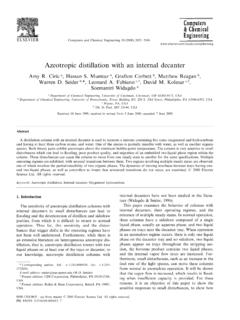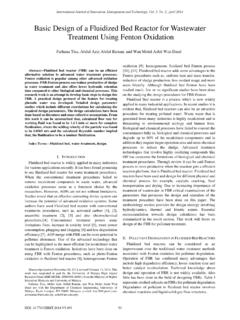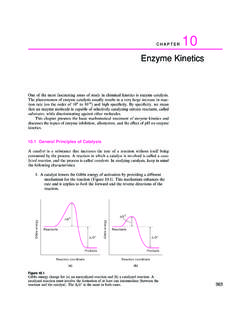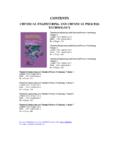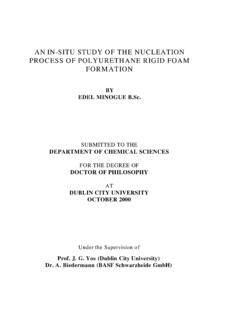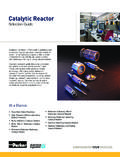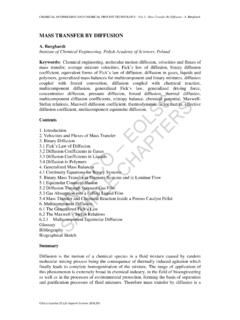Transcription of High Performance Gas-Liquid Reaction Technology
1 high Performance Gas-Liquid Reaction Technology Rene F. Duveen HH Technology Corp., Sissach, Switzerland Abstract high Performance of reactors is often related to high throughput or high product quality. Scale-up ability, flexibility in operating parameters, product equivalence and new reactor concepts are other factors to be considered. Mass transfer in loop reactors is discussed and compared with other gas/ liquid contacting systems. Guidelines for reactor selection are given. In the chemical and food industry the importance of achieving product equivalence in different sizes of reactors is an increasing requirement. Solutions to meet these requirements are discussed.
2 With practical examples from industrial applications it is shown that other concepts may improve the Performance of a reactor. A Reaction concept for oxidations, the flexibility to work with variable working volumes and a concept for continuous hydrogenation are presented. Future trends in Gas-Liquid Reaction Technology are outlined. Introduction Gas-Liquid reactions are widely used in the process industries for the manufacture of organic intermediates. Many of these chemical reactions are carried out in the presence of homogeneous or heterogeneous catalysts. Typical examples are alkylations, alkoxylations, aminations, carbonylations, hydrogenations and oxydations.
3 Many different types of reactor systems are available for these reactions and have been described in literature. Most of these systems are commercially used. However, the initial development of a chemical Reaction is often done in a rather simple laboratory autoclave, latterly more often in more sophisticated laboratory stirred vessel systems. As soon as the chemistry is investigated and optimized, the process and chemical engineers are faced with the problem of selecting a practical and economic Reaction system. The chemical engineer's role is to use the results from the chemist in selecting a Reaction system with a high Performance . By Performance , we mean the ability of this system to do the Reaction well.
4 This Performance may be expressed in the ability to: - reproduce the chemist's laboratory process on an industrial scale - achieve a high selectivity and yield - reach a high capacity and throughput - demonstrate an excellent reproducibility - allow flexibility with respect to production parameters (turn down ratio, variation of grades, etc.) - perform the Reaction in a safe way - fulfill the requirements of environmental regulations The objective of this paper is to cover some of the aspects that are important in the selection procedure and to discuss some solutions with practical examples. Reaction Kinetics and Mass Transfer Some chemical reactions may be done at conditions where the mass transfer from the gas to the liquid is not limiting at all and where only the conversion rate will dictate the type and size of the reactor system.
5 As a matter of fact, most chemists will firstly choose such conditions in their laboratory autoclaves that the effects of mass transfer will be excluded. For developing a new chemistry and to investigate the kinetics, the chemist may choose - low substrate concentrations - high stirring speeds - low temperatures - high pressures - low catalyst concentrations Only after finding the kinetics, will he start to change parameters in order to improve the economics of the process. This is often the moment, where it is found that the Reaction becomes mass transfer controlled. Changing the Reaction parameters will probably result in problems such as, undesired side reactions , difficulty in controlling the temperature or catalyst deactivation effects.
6 However, it is important to find the conditions where mass transfer starts to play a role, because mass transfer could be a limiting factor on the larger scale reactors. Where the chemical Reaction is solely controlled by the kinetics, the scale-up to industrial size reactors should not be too difficult and the type and size of reactor is mainly dictated by the desired capacity. The aspects of scaling-up stirred vessels and Loop reactors has very recently been reported by Dierendonck, et al. From this paper, it may be concluded that the scale-up of stirred vessels can be very complex and difficult. The scale-up of loop reactors however, seems to be much easier and more reliable.
7 Loop Reactor The Loop Reactor ( ) consists of a Reaction autoclave, a circulation pump, a heat exchanger and a venturi type ejector ( ). This system thus requires the same number of elements as a stirred vessel system, but is arranged in a completely different way. The Reaction vessel of a Loop Reactor does not need baffles and is normally built with a larger L/D than the stirred vessel and is thus lower in cost, especially for high -pressure reactions . The external heat exchanger (instead of coils or internal exchangers) can be built as large as needed and is not limited by the reactor's working volume. The full heat exchanger area is available, also if the reactor is operated with reduced working volumes.
8 The circulation pump (instead of an agitator) allows high power input per m3 working volume in those cases where high mass transfer rates have to be achieved. The maximum power input of stirred vessels is often a limiting factor, especially for large reactors. New pump designs are now available with mechanical seals that can be operated at pressures of up to 200 bar g. A unique impeller and a special hydrodynamic pump house profile allow pumping of liquids with a high solid content and high gas loads, without the aid of an inducer and thus avoiding abrasion problems where heterogeneous catalysts are used. The down flow Jet Mixer (instead of a sparger or other gas distribution system) is a high Performance gassing tool.
9 The ability to finely disperse very small gas bubbles to the liquid with a Gas-Liquid ratio between and , or even more, makes this an ideal tool for Gas-Liquid reactions . The hydrodynamics and the mass transfer characteristics of a Loop Reactor have been investigated and reported by several authors. (Henzler (1981/1982/1983), Zahradnik et al. (1982/1991), Dutta et al. (1987), van Dierendonck et al. (1988), Cramers et al. (1992/1993) and Havelka (1997)). GasRaw material Catalyst ProductFigure 1 Loop Reactor liquid Flow Nozzle Gas suction chamber Free liquid jet Mixing shock zone Draft tube (bubble flow) Diffuser Gas Figure 2 Venturi Ejector The effect of the Jet Mixer is not only resulting in a high gas fraction in the vessel, but is also offering a high mass transfer rate within the Jet Mixer itself.
10 (Table 1.) Table 1. Comparison of different Gas-Liquid Reaction contact systems Contact System Bubble size (mm) Energy dissipation (W/kg) Mass transfer coefficient KLa (s'1) Bubble Column 3-4 1 - Stirred Vessel 2-3 3 Loop Reactor 1-2 5-15 - Jet Mixer 500 - 3000 4-6 Impact Zone < 5000 - 30000 10- 15 All data for a water/air coalescing system (ambient/atmospheric) The Mass transfer characteristics of a Jet Mixer have been reported and the typical relation of the mass transfer coefficient to the Gas-Liquid ratio is shown in It is showing an optimal KLa at a Gas-Liquid ratio between and The Mass transfer characteristics of the Reaction vessel are typically proportional to the Gas-Liquid ratio and are shown in The overall mass transfer of a Loop Reactor is thus a combination of both as shown in From this graph it may be concluded that high KLa values can be obtained at reasonably low Gas-Liquid ratios, because of the high contribution in mass transfer of the Jet Mixer.
